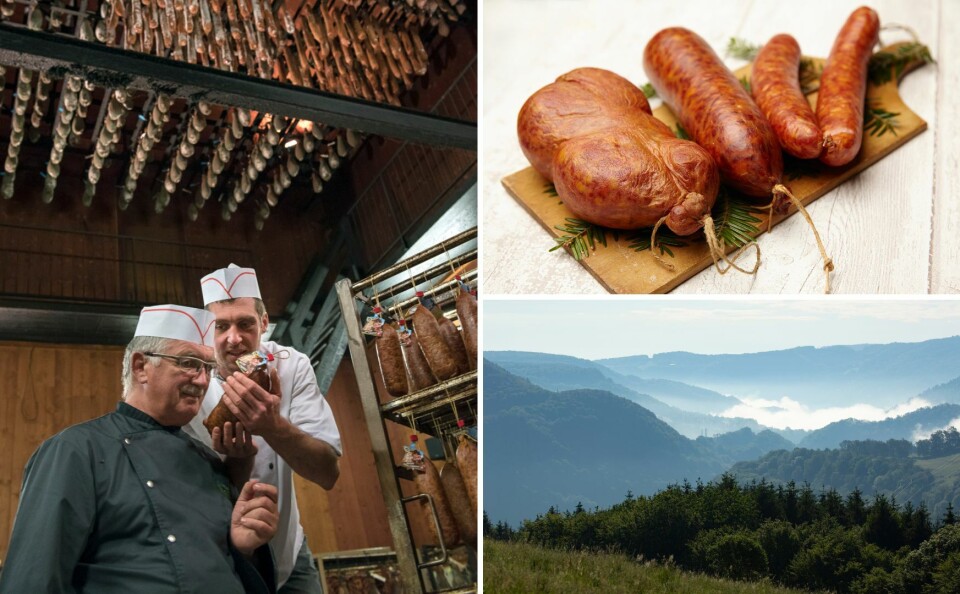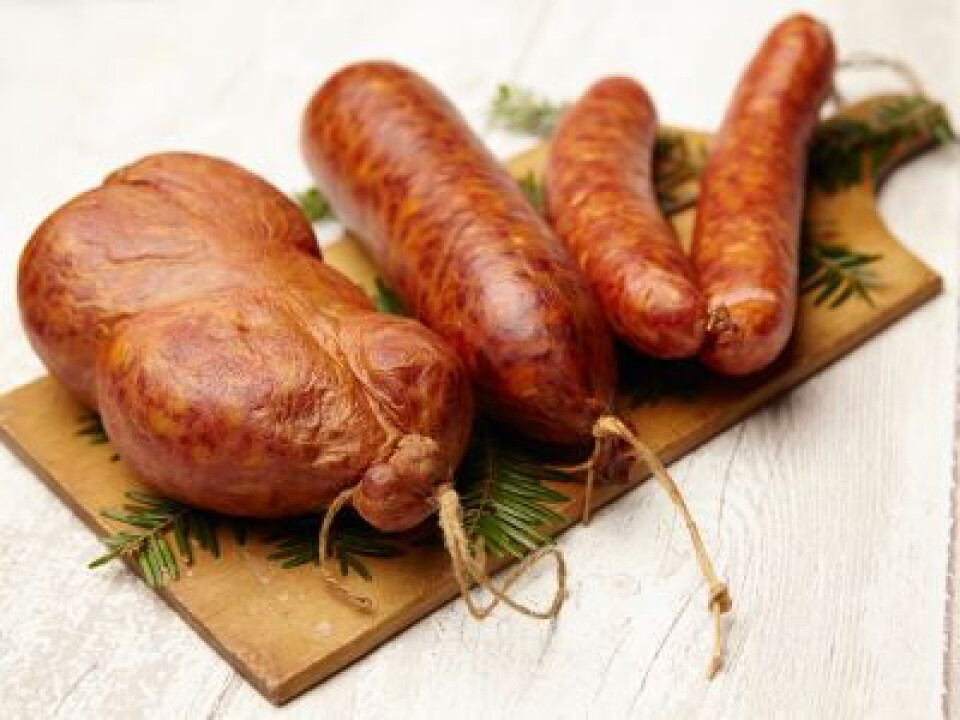-
Meet the traditional choucroute makers of Alsace
Choucrouterie Angsthelm & Fils craft organic and sustainable choucroute using homegrown cabbages
-
Fire-hit bakery finds lifeline through unique partnership with butcher
Local residents rally to help two well-known traders
-
French mushrooms poisoned my friend - learn to be careful
Columnist Sue Adams gives advice on sourcing wild champignons
How to recognise France’s two famous smoked sausages
The pork sausages Montbéliard and Morteau are both made in the historic region of Franche-Comté where their subtle differences matter

Just over an hour’s drive separates the towns of Morteau and Montbéliard, close to Besançon, Mulhouse and Basel as well as Neuchâtel in Switzerland.
Here, in the historic region of Franche-Comté, in the departments of Doubs, Jura, Haute-Saône and Territoire de Belfort, two of France’s most famous smoked sausages are produced in the same area.
Often confused, these two cousins are only a few degrees apart.
Morteau and Montbéliard similarities and differences
Ideal winter accompaniments to choucroute, potée (stew), lentils or potatoes, they are so closely related that their PGIs – the European quality label – are managed by a single organisation, A2M, the Association for the protection and promotion of Franche-Comté PGI charcuterie and cured meats.
“To sum up, the geographical area of production is the same and they are made from the same meat with lean and fat pork,” explains its president, Jean-François Nicolet, who also runs Tuyé du Papy Gaby with his son Pascal, one of the region’s emblematic smokehouses based in the pretty village of Gilley, near Morteau.
He adds: “after that, what changes is the format: Montbéliard, closed with string, is smaller than Morteau, which is closed with a wooden peg.
“The grinding of the meat is also different. For Morteau, it’s ground to 8mm in diameter, and for Montbéliard, 6mm, so the stuffing is finer than Morteau.
“The basic seasonings, mainly pepper, are the same, but for Montbéliard, cumin is mandatory. Originally, it was caraway, called wild cumin in Franche-Comté, because in the old days people used what they had on hand.”

Photo: Tuyé du Papy Gaby smokehouse; Credit: Tuyé du Papy Gaby
Morteau’s history dates back to the 16th century
Like many French specialities, Morteau sausage, known locally as ‘la bonne saucisse’, and Montbéliard sausage, often called ‘Montbé’ for short, have their origins in ancient traditions.
Morteau’s dates back to the 16th century, when peasants from the French and Swiss Jura conquered the immense fir and spruce forests of the region and began building huge farms capable of sheltering people, animals and hay during the harsh winters.
At the centre of these farms was a tuyé (pronounced like ‘tué’ in French), a huge pyramid-shaped wooden hood 12 to 15 metres high rising above a hearth in which meat was hung to smoke.
Read more: Andouille: Meet the makers who defend this gutsy French sausage
Montbéliard sausage origins even older
The origins of Montbéliard sausage may go back even further, as evidenced by the Gallo-Roman meat smokers found at Mandeure, near Montbéliard, and by the 14th century it was already known as andouille or andouillette de Montbéliard. Served warm with potatoes and salad, it was a Montbéliard diet staple, and enjoyed at fairs, markets and other important events.
Now a mainstay of Franche-Comté gastronomy, alongside such famous cheeses as Comté, Mont d’Or, Morbier, Bleu de Gex and Cancoillotte, Morteau and Montbéliard were awarded a PGI in 2010 and 2013 respectively.
All producers are good thanks to rigorous rules
No doubt because of their smaller size, Montbéliards, often sold in pairs, are consumed more in towns and cities, and their annual production exceeds that of the more rural and homely Morteau: 6,000 tonnes compared with 5,000.
However, the number of producers is roughly the same: around thirty for each, and most of them make both. It should also be noted that 80% of production is dominated by two industrial groups.
“But the sausages made by these manufacturers, whoever they are, are all good,” says Jean-François Nicolet.
“We have such rigorous specifications that, ultimately, there really isn’t much difference between their products.
“We organise competitions every year, and it’s always difficult to decide between the competitors.”

Photo: Mincing the meat to specific rules: Credit: Julien Kaufmann
Smoke flavour comes from fir or spruce logs
The production process for both sausages is similar. Once ground and seasoned, the pork is encased in natural casing, the largest casing reserved for Morteau, the smallest for Montbéliard.
Once the outside of their casings have dried, the sausages are placed on trolleys to be smoked, often in the same smokehouses. This is the case at Papy Gaby, whose tuyé, one of the tallest in the Doubs, is 17m high and open to visitors.
“Smoking is really the most delicate part,” says Jean-François Nicolet.
“It requires as much skill as ageing cheese. Under the sausage trolleys, there is a steel floor pierced with holes through which the smoke rises.
“The smoke comes from fir or spruce logs and sawdust, and there must be no flames. Otherwise, the fat deteriorates and the sausages take on a bad taste.
“Smoking times, which are different for Morteau and Montbéliard, generally last three to four days, but they can vary depending on the weather.
“The operator must judge whether the sausage is smoked enough.”
Read more: French food notes: The salty tale behind Jambon de Bayonne
The ‘Jésus’ is to Morteau like a magnum to a bottle of wine
In this way, Papy Gaby, which has existed since the 1970s and is named for its founder, Gabriel Marguet, aka ‘Papy Gaby’, produces around 60 tonnes of Morteau and 10 tonnes of Montbéliard annually, alongside other charcuterie products.
They are sold in gourmet shops or the on-site boutique. The price for Morteau is around €15 per kilo, and €13 for Montbéliard. You can also buy ‘Jésus de Morteau’, a large sausage that can weigh from 800grams to one kilo.
The ‘Jésus’, described as being to Morteau like a magnum to a bottle of wine, was traditionally eaten at Christmas, thinly sliced.

Photo: Jésus de Morteau (thickest), Morteau and Montbéliard; Credit: Média Talents
How to cook and serve the sausages
To prepare the sausages, simply cook them in water, but never pierce them, as water will penetrate the sausages and remove all their flavour.
Recommended cooking time is 20-25 minutes for Montbéliard and 35-45 minutes for Morteau. But at Mistigri, a Besançon restaurant specialising in local products, chef Aude Bonnet is in favour of cooking the sausages for much longer.
“I prepare the Morteau as in the old days,” she says. “I simmer them over a very low flame, for at least four hours, and the sausage fat gradually evaporates. Ideally, it’s best to let the sausages cool, skim off the fat and then cook them again.
“Cooking them for a long time removes the fattiness that can be heavy on the stomach. Also, some sausages contain more fat than others. I choose the leanest ones.”
She serves the sausages sliced with rösti, a Swiss-German dish made with grated potatoes cooked in butter in a frying pan with a little onion, accompanied by a green salad and mustard sauce.
“You can eat them with anything,” says Jean-François Nicolet.
“With pasta, with chips, with lentils, with cabbage, with stew. Once cooked, you can cut the Morteau into thin slices and bake them in the oven where they twist like crisps. They’re excellent with a green salad.
“To accompany them, you need a wine that’s not too sweet, like a Chardonnay or a Pinot from the Jura.”
He adds: “in summer, some people prick the sausages, put them in tin foil with red wine and a branch of fir, and cook them over the coals. And with that, they drink a nice rosé.”
Tuyé du papy Gaby, Le Mistigri, 1, Rue Général Rolland, 25000 Besançon
Related articles
The French brothers who hand make three hundred types of jam
How little French ravioli became part of the Dauphiné food heritage
RECIPES: real French charcuterie of rabbit rillettes, pork liver pâté
























